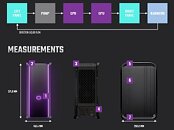- Joined
- Oct 9, 2007
- Messages
- 47,670 (7.43/day)
- Location
- Dublin, Ireland
| System Name | RBMK-1000 |
|---|---|
| Processor | AMD Ryzen 7 5700G |
| Motherboard | Gigabyte B550 AORUS Elite V2 |
| Cooling | DeepCool Gammax L240 V2 |
| Memory | 2x 16GB DDR4-3200 |
| Video Card(s) | Galax RTX 4070 Ti EX |
| Storage | Samsung 990 1TB |
| Display(s) | BenQ 1440p 60 Hz 27-inch |
| Case | Corsair Carbide 100R |
| Audio Device(s) | ASUS SupremeFX S1220A |
| Power Supply | Cooler Master MWE Gold 650W |
| Mouse | ASUS ROG Strix Impact |
| Keyboard | Gamdias Hermes E2 |
| Software | Windows 11 Pro |
Cooler Master at the 2023 International CES showed off the Cooling X, a patent-pending unique desktop PC architecture by the company where the liquid cooling of the CPU and GPU isn't confined to a couple of closed loop AIOs, but rather a giant liquid-cooling loop that even involves the side-panels of the case itself, that double up as additional heat-dissipation surfaces. Notice how some compact fanless cases use extruded-aluminium body panels that double up as heatsinks, to cool the hot components? The Cooling X re-imagines this, where instead of dissipating heat from a heatpipe, the extruded-aluminium body panels have coolant channels, so some of the heat from the liquid-cooling loop is dissipated. These panels supplement a conventional liquid-cooling radiator that's located along the rear panel, which has active ventilation. The liquid-cooling loop cools the processor and GPU.
For its compact dimensions of just 266 mm x 149 mm x 371 mm (LxWxH), the Cooling X prebuilt packs some mighty high-end hardware—an AMD Ryzen 9 5950X 16-core processor, and a Radeon RX 6800 XT GPU up to 64 GB of dual-channel DDR4-3200 memory, two 2 TB M.2 NVMe SSDs, and a homebrew 850 W 80 Plus Gold SFX power supply. For now Cooling X is just a codename, and Cooler Master intends to take this concept forward with high-performance gaming/creator prebuilt desktops sold under its own marquee.




View at TechPowerUp Main Site
For its compact dimensions of just 266 mm x 149 mm x 371 mm (LxWxH), the Cooling X prebuilt packs some mighty high-end hardware—an AMD Ryzen 9 5950X 16-core processor, and a Radeon RX 6800 XT GPU up to 64 GB of dual-channel DDR4-3200 memory, two 2 TB M.2 NVMe SSDs, and a homebrew 850 W 80 Plus Gold SFX power supply. For now Cooling X is just a codename, and Cooler Master intends to take this concept forward with high-performance gaming/creator prebuilt desktops sold under its own marquee.




View at TechPowerUp Main Site




